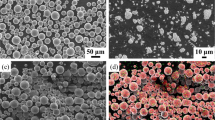Abstract
In this paper, high density of dislocations, grain boundaries and nanometer-scale α precipitates were introduced to a metastable Ti–36Nb–5Zr alloy (wt%) through a thermo-mechanical approach including severe cold rolling and short-time annealing treatment. The martensitic transformation was retarded, and the β phase with low content of β stabilizers was retained at room temperature after the thermo-mechanical treatment. As a result, both low modulus (57 GPa) and high strength (950 MPa) are obtained. The results indicate that it is a feasible strategy to control martensitic transformation start temperature through microstructure optimization instead of composition design, with the aim of fabricating low modulus β-type Ti alloy.




Similar content being viewed by others
References
Geetha M, Singh AK, Asokamani R, Gogia AK. Ti based biomaterials, the ultimate choice for orthopaedic implants—a review. Prog Mater Sci. 2009;54(3):397.
Long M, Rack HJ. Titanium alloys in total joint replacement—a materials science perspective. Biomaterials. 1998;19(18):1621.
Chen Q, Thouas GA. Metallic implant biomaterials. Mater Sci Eng R. 2015;87:1.
Niinomi M. Mechanical biocompatibilities of titanium alloys for biomedical applications. J Mech Behav Biomed Mater. 2008;1(1):30.
Biesiekierski A, Wang J, Abdel-Hady Gepreel M, Wen C. A new look at biomedical Ti-based shape memory alloys. Acta Biomater. 2012;8(5):1661.
Saito T, Furuta T, Hwang J-H, Kuramoto S, Nishino K, Suzuki N, Chen R, Yamada A, Ito K, Seno Y, Nonaka T, Ikehata H, Nagasako N, Iwamoto C, Ikuhara Y, Sakum T. Multifunctional alloys obtained via a dislocation-free plastic deformation mechanism. Science. 2003;300(5618):464.
Hao YL, Zhang ZB, Li SJ, Yang R. Microstructure and mechanical behavior of a Ti–24Nb–4Zr–8Sn alloy processed by warm swaging and warm rolling. Acta Mater. 2012;60(5):2169.
Jin M, Lu X, Qiao Y, Wang LN, Volinsky AA. Fabrication and characterization of anodic oxide nanotubes on TiNb alloys. Rare Met. 2016;35(2):140.
Qu WT, Sun XG, Yuan BF, Li KM, Wang ZG, Li Y. Tribological behaviour of biomedical Ti–Zr-based shape memory alloys. Rare Met. 2017;36(6):478.
Abdel-Hady M, Hinoshita K, Morinaga M. General approach to phase stability and elastic properties of β-type Ti-alloys using electronic parameters. Scr Mater. 2006;55(5):477.
Banerjee D, Williams JC. Perspectives on titanium science and technology. Acta Mater. 2013;61(3):844.
Guo S, Meng Q, Zhao X, Wei Q, Xu H. Design and fabrication of a metastable β-type titanium alloy with ultralow elastic modulus and high strength. Sci Rep. 2015;5:14688.
Hu L, Guo S, Meng QK, Zhao XQ. Metastable β-type Ti–30Nb–1Mo–4Sn alloy with ultralow Young’s modulus and high strength. Metall Mater Trans A. 2014;45(2):547.
Hao YL, Li SJ, Sun SY, Zheng CY, Yang R. Elastic deformation behaviour of Ti–24Nb–4Zr–7.9Sn for biomedical applications. Acta Biomater. 2007;3(2):277.
Yu ZG, Xiong CY, Xue PF, Li Y, Yuan BF, Qu WT. Shape memory behavior of Ti–20Zr–10Nb–5Al alloy subjected to annealing treatment. Rare Met. 2016;35(11):831.
Sun F, Nowak S, Gloriant T, Laheurte P, Eberhardt A, Prima F. Influence of a short thermal treatment on the superelastic properties of a titanium-based alloy. Scr Mater. 2010;63(11):1053.
Niinomi M. Fatigue performance and cyto-toxicity of low rigidity titanium alloy, Ti–29Nb–13Ta–4.6Zr. Biomaterials. 2003;24(16):2673.
Hao YL, Wang HL, Li T, Cairney JM, Ceguerra AV, Wang YD, Wang Y, Wang D, Obbard EG, Li SJ, Yang R. Superelasticity and tunable thermal expansion across a wide temperature range. J Mater Sci Technol. 2016;32(8):705.
Wang HL, Hao YL, He SY, Du K, Li T, Obbard EG, Hudspeth J, Wang JG, Wang YD, Wang Y, Prima F, Lu N, Kim MJ, Cairney JM, Li SJ, Yang R. Tracing the coupled atomic shear and shuffle for a cubic to a hexagonal crystal transition. Scr Mater. 2017;133:70.
Xu W, Wu X, Calin M, Stoica M, Eckert J, Xia K. Formation of an ultrafine-grained structure during equal-channel angular pressing of a β-titanium alloy with low phase stability. Scr Mater. 2009;60(11):1012.
Cai MH, Lee CY, Kang S, Lee YK. Fine-grained structure fabricated by strain-induced martensite and its reverse transformations in a metastable β titanium alloy. Scr Mater. 2011;64(12):1098.
Nag S, Banerjee R, Srinivasan R, Hwang JY, Harper M, Fraser HL. ω-Assisted nucleation and growth of α precipitates in the Ti–5Al–5Mo–5V–3Cr–0.5Fe β titanium alloy. Acta Mater. 2009;57(7):2136.
Otsuka K, Ren X. Physical metallurgy of Ti–Ni-based shape memory alloys. Prog Mater Sci. 2005;50(5):511.
Hao YL, Li SJ, Sun SY, Yang R. Effect of Zr and Sn on Young’s modulus and superelasticity of Ti–Nb-based alloys. Mater Sci Eng A. 2006;441(1–2):112.
Inamura T, Fukui Y, Hosoda H, Wakashima K, Miyazaki S. Mechanical properties of Ti–Nb biomedical shape memory alloys containing Ge or Ga. Mater Sci Eng C. 2005;25(3):426.
Tane M, Akita S, Nakano T, Hagihara K, Umakoshi Y, Niinomi M, Mori H, Nakajima H. Low Young’s modulus of Ti–Nb–Ta–Zr alloys caused by softening in shear moduli c′ and c44 near lower limit of body-centered cubic phase stability. Acta Mater. 2010;58(20):6790.
Bertrand E, Castany P, Gloriant T. Investigation of the martensitic transformation and the damping behavior of a superelastic Ti–Ta–Nb alloy. Acta Mater. 2013;61(2):511.
Matsumoto H, Watanabe S, Hanada S. Microstructures and mechanical properties of metastable β TiNbSn alloys cold rolled and heat treated. J Alloys Compd. 2007;39(1–2):146.
Sun F, Hao YL, Nowak S, Gloriant T, Laheurte P, Prima F. A thermo-mechanical treatment to improve the superelastic performances of biomedical Ti–26Nb and Ti–20Nb–6Zr (at.%) alloys. J Mech Behav Biomed Mater. 2011;4(8):1864.
Hao YL, Li SJ, Yang R. Biomedical titanium alloys and their additive manufacturing. Rare Met. 2016;35(9):661.
Acknowledgements
This work was financially supported by the National Natural Science Foundation of China (No. 51601217), the Natural Science Foundation of Jiangsu Province (No. BK20160255) and the Fundamental Research Funds for the Central Universities (No. 2017QNA04).
Author information
Authors and Affiliations
Corresponding author
Rights and permissions
About this article
Cite this article
Meng, QK., Huo, YF., Ma, W. et al. Design and fabrication of a low modulus β-type Ti–Nb–Zr alloy by controlling martensitic transformation. Rare Met. 37, 789–794 (2018). https://doi.org/10.1007/s12598-018-1055-5
Received:
Revised:
Accepted:
Published:
Issue Date:
DOI: https://doi.org/10.1007/s12598-018-1055-5




